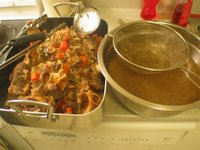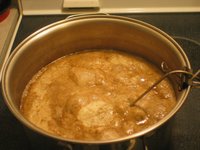 1. I placed all my bones in a roasting pan and roasted them slowly in the oven for an hour or two so that they could develop that beautiful and delicious brown crust.
1. I placed all my bones in a roasting pan and roasted them slowly in the oven for an hour or two so that they could develop that beautiful and delicious brown crust. 2. I then prepared a mirepoix (celery, carrot and onion). You noticed that I didn't peel my onions? No worries, we have to strain everything at the end so it's ok to be lazy.
2. I then prepared a mirepoix (celery, carrot and onion). You noticed that I didn't peel my onions? No worries, we have to strain everything at the end so it's ok to be lazy. 3. When the bones were nicely browned, I added the mirepoix to the roasting pan and returned the whole pan in the oven for another 30 to 45 minutes.
3. When the bones were nicely browned, I added the mirepoix to the roasting pan and returned the whole pan in the oven for another 30 to 45 minutes. 4. I then prepared a bouquet garni. From left to right: parsley stems, thyme, leek and a few basil in the lower left corner.
4. I then prepared a bouquet garni. From left to right: parsley stems, thyme, leek and a few basil in the lower left corner. 5. I then added everything to my stockpot
5. I then added everything to my stockpot
6. Deglazed the roasting pan with red wine. And added the liquid to my stock pot.
 7. Covered everything with cold water.
7. Covered everything with cold water. 8. I then placed an upside down metal steamer basket and placed a heavy cast iron lid on top to maintain all the ingredients submerged. I first saw Alton Brown doing this on TV and thought it was a neat trick to use. Then the whole thing simmered for 5 to 7 hours (some people suggest 8 to 10 but who on this planet have that much time to spare watching a pot at home?)
8. I then placed an upside down metal steamer basket and placed a heavy cast iron lid on top to maintain all the ingredients submerged. I first saw Alton Brown doing this on TV and thought it was a neat trick to use. Then the whole thing simmered for 5 to 7 hours (some people suggest 8 to 10 but who on this planet have that much time to spare watching a pot at home?) 9. Now the boring but essential part of the job: skimming! For the first hour or two, I skimmed the foam, fat and residues that floated on the surface every 10 to 15 minutes... and then every hour for the last hours. I made sure my stock was not boiling each time. To do this, I also used an alarm thermometer which rang every time the temperature approached boiling point.
9. Now the boring but essential part of the job: skimming! For the first hour or two, I skimmed the foam, fat and residues that floated on the surface every 10 to 15 minutes... and then every hour for the last hours. I made sure my stock was not boiling each time. To do this, I also used an alarm thermometer which rang every time the temperature approached boiling point. 10. After these long hours, I finally strained my stock. The result was, of course, veal stock.
10. After these long hours, I finally strained my stock. The result was, of course, veal stock. 11. The problem was that my stock lacked flavour so I decided to boost its flavour by browning some veal cube (I plan to use them for a 'blanquette de veau', a french creamy veal stew). I then added some stock, let reduce and browned again. Repeated the operation a couple of times and finally added all of the remaining stock and let simmer for another one or two hour with an extra dose of browned mirepoix and tomato paste. Now I think, this whole operation was a mistake as it clouded my stock and exaggeratedly intensified the vegetable flavour of my stock instead of the meat flavour.
11. The problem was that my stock lacked flavour so I decided to boost its flavour by browning some veal cube (I plan to use them for a 'blanquette de veau', a french creamy veal stew). I then added some stock, let reduce and browned again. Repeated the operation a couple of times and finally added all of the remaining stock and let simmer for another one or two hour with an extra dose of browned mirepoix and tomato paste. Now I think, this whole operation was a mistake as it clouded my stock and exaggeratedly intensified the vegetable flavour of my stock instead of the meat flavour. 12. Faced with a cloudy stock I had to clarify it using egg whites and egg shells. I first cooled my stock to room temperature (by placing the pot outside and adding a few icepack in it) and then I mixed in about 10 egg whites and their shells. I simmered my stock again and waited for a raft to form on the surface.
12. Faced with a cloudy stock I had to clarify it using egg whites and egg shells. I first cooled my stock to room temperature (by placing the pot outside and adding a few icepack in it) and then I mixed in about 10 egg whites and their shells. I simmered my stock again and waited for a raft to form on the surface. 13. The raft did form after a few minutes and I strained my stock through a fine sieve and several layers of cheese cloth. My stock was much clearer now. (can you see my thermometer attached to the pot with a paper clip on this picture?)
13. The raft did form after a few minutes and I strained my stock through a fine sieve and several layers of cheese cloth. My stock was much clearer now. (can you see my thermometer attached to the pot with a paper clip on this picture?)
14. Then, still using my thermometer to avoid reaching boiling point, I reduced my stock to a meat glace stage.
The result, as I said, was a bit disappointing but at least I think I was able to pinpoint my mistakes. Hopefully, I'll get better with time. By the way, I welcome any ideas and tricks to help me improve my stock.


3 comments:
A few points--
1. Veal naturally has a delicate flavor. Cut down on the proportion of vegetation to bones.
2. Veal bones (or any bones, for that matter) have far less flavor than meat. That's why traditional stocks call for meaty shanks, which admittedly is an expensive proposition with veal.
3. Don't use onion skins in veal stock. They contribute a huge aroma that persists.
4. When making meat glace, use a primary stock from bones to moisten veal shanks that you've browned in a skillet. Reduce to a film, let it caramelize, and deglaze with more stock. Repeat a few times, and then add the rest of the primary stock and reduce to the consistency you want. For some reason, meat aromas are both more subtle and fleeting than vegetable aromas. If you make the glace straightaway by reducing the primary bone stock, you're going to eliminate any trace of meatiness.
5. Instead of making meat glace, try making a classic demi-glace from a sauce espagnole. It's definitely old-fashioned, but if done right, you get the same unctuous consistency with correspondingly little loss of flavor.
Thanks for the comments and suggestions. I'll try some of them out next time I make stock.
Let your stock simmer for 24 hours, as long as the heat is low it should be okay
Post a Comment